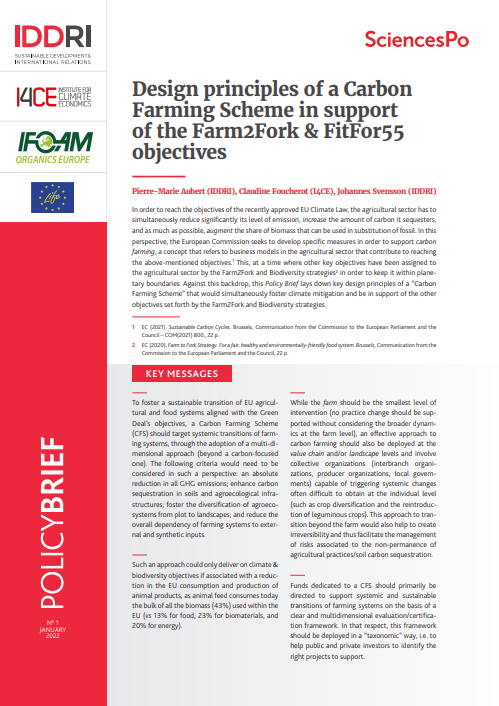Design principles of a carbon farming scheme in support of the Farm2Fork & FitFor55 objectives
In order to reach the objectives of the recently approved EU Climate Law, the agricultural sector has to simultaneously reduce significantly its level of emission, increase the amount of carbon it sequesters, and augment the production of biomass in substitution of fossil fuel – which are to be phased out in the short term. In this perspective, the European Commission seeks to develop specific measures in order to support carbon farming, a concept that refers to business models in the agricultural sector that contribute to reaching the above mentioned objectives. This, at a time where other key objectives have been assigned to the agricultural sector by the Farm2Fork & Biodiversity strategies in order to bring it back within a safe operating space. Against this backdrop, this policy brief lays down key design principles of a “Carbon farming scheme” that would simultaneously foster climate mitigation and be in support of the other objectives set forth by the Farm2Fork and biodiversity strategies.
Key messages:
- To be coherent with the multiple objectives of the Green Deal for the agricultural sector, a carbon farming scheme should target not only marginal changes in practices but also systemic transitions of farming systems, through the adoption of a multi-dimensional approach (beyond a carbon-focused one). The following criteria and objectives would need to be considered to support carbon farming in such a perspective: reduce GHG emissions/ha; enhance carbon sequestration in soils and agroecological infrastructures; foster the diversification of agroecosystems from plot to landscapes; and reduce the overall dependency of farming systems to external and synthetic inputs
- Such an approach could only deliver on climate & biodiversity objectives if associated with a reduction in the EU consumption and production of animal products, whose production today absorbs the vast majority (45%) of all the biomass consumed within the EU under the form of feed (vs 13% of that biomass consumed for food, 23% used as biomaterials, and 20% used for energy purposes).
- While the farm should be the smallest level of intervention (no practice change should be supported without considering the broader dynamics at the farm level), an effective approach to carbon farming should also be deployed at the value chain and / or landscape levels and involve collective organizations (interbranch organizations, producer organizations, local governments) capable of triggering the above mentioned systemic changes difficult to obtain at the individual level (such as crop diversification and the reintroduction of leguminous crops). This approach to transition beyond the farm would also help to create irreversibility and thus facilitate the management of risks associated to the non-permanence of agricultural practices / soil carbon sequestration.
- To concretely support the development of carbon farming initiative, a clear framework should be established elaborating on existing schemes (Label Bas Carbone and others), and deployed in a “taxonomic” way; as such, the objective of the (certification) framework is less to generate credit carbon – whose selling on the secondary market would in any case generate way less money that what is actually needed to foster the type of transition that are needed – than to direct public and private investments towards well identified virtuous projects.
